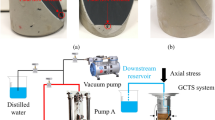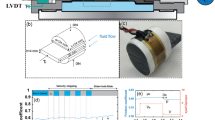Abstract
Fluid injection-induced fracture slip during hydraulic stimulation of shales may be seismic or aseismic with the slip mode potentially influencing the evolution of permeability and subsequent shale gas production. We report a series of friction-permeability tests with constant and stepped velocities on planar saw-cut fractures of Longmaxi shale, Green River shale and Marcellus shale. In particular we explore the additive effect of stepped velocity on fracture permeability evolution relative to the background permeability driven at constant velocity. Fracture permeability decreases at larger slip displacement at constant velocity presumably due to asperity degradation and clay swelling. Sudden up-steps in slip velocity temporarily enhance fracture permeability as a result of shear dilation on hard minerals, but permeability net decreases with increasing slip displacement as wear products fill the pore space. Fracture surface roughness is the link between the fracture permeability and friction coefficient, which are both influenced by mineralogical composition. The fractures and sheared-off particles in the tectosilicate-rich and carbonate-rich shales dilate to increase fracture permeability, whereas asperity comminution readily occurs in the phyllosilicate-rich shale to reduce fracture permeability. The results potentially improve our ability to facilitate shale gas extraction and to mitigate the associated seismic risks.
Similar content being viewed by others
Abbreviations
- α :
-
Constant representing effective hydraulic aperture evolution, dimensionless
- ΔP :
-
Pore pressure difference between upstream and downstream reservoirs, Pa
- Δk :
-
Change in permeability, m2
- η :
-
Viscosity of distilled water, Pa·s
- θ i+1 :
-
State variable after a stepped velocity Vi+1, dimensionless
- μ i :
-
Friction coefficient at reference velocity Vi, dimensionless
- A :
-
Scanning area, m2
- a :
-
Scaling factor representing direct effect in rate-and-state friction laws, dimensionless
- b :
-
Scaling factor representing evolutionary effect in rate-and-state friction laws, dimensionless
- D c :
-
Critical slip distance, m
- e h :
-
Effective hydraulic aperture, m
- e max :
-
Maximum effective hydraulic aperture, m
- e min :
-
Minimum effective hydraulic aperture, m
- k :
-
Fracture permeability, m2
- k ’ :
-
Estimated permeability without slip velocity change, m2
- k real :
-
Measured permeability after slip velocity change, m2
- k trans :
-
Measured permeability before slip velocity change, m2
- L :
-
Fracture length, m
- Q :
-
Flow rate, m3/s
- R c :
-
Contact-area ratio, dimensionless
- RMS:
-
Root mean square of aperture height, m
- S a :
-
Arithmetic mean of aperture height, m
- S z :
-
Maximum difference of aperture height, m
- W :
-
Fracture width, m
- z :
-
Elevation of scanned point (x, y)
References
Brown SR (1987) Fluid flow through rock joints: the effect of surface roughness. J Geophys Res 92(B2):1337–1347
Candela T, Renard F, Bouchon M, Brouste A, Marsan D, Schmittbuhl J, Voisin C (2009) Characterization of fault roughness at various scales: implications of three-dimensional high resolution topography measurements. Pure Appl Geophys 166(10–11):1817–1851
Candela T, Brodsky EE, Marone C, Elsworth D (2014) Laboratory evidence for particle mobilization as a mechanism for permeability enhancement via dynamic stressing. Earth Planet Sci Lett 392:279–291
Candela T, Brodsky EE, Marone C, Elsworth D (2015) Flow rate dictates permeability enhancement during fluid pressure oscillations in laboratory experiments. J Geophys Res Solid Earth 120(4):2037–2055
Chenevert ME (1970) Shale alteration by water adsorption. J Pet Technol 22(09):1141–1148
De Barros L, Guglielmi Y, Rivet D, Cappa F, Duboeuf L (2018) Seismicity and fault aseismic deformation caused by fluid injection in decametric in situ experiments. Com Rend Geosci 350:464–475
Dieterich JH (1978) Time-dependent friction and the mechanics of stick-slip. Pure Appl Geophys 116(4–5):790–806
Dieterich JH (1979) Modeling of rock friction: 1. Experimental results and constitutive equations. J Geophys Res Solid Earth 84(5):2161–2168
Elkhoury JE, Niemeijer A, Brodsky EE, Marone C (2011) Laboratory observations of permeability enhancement by fluid pressure oscillation of in situ fractured rock. J Geophys Res Solid Earth 116:B02311
Elsworth D, Spiers CJ, Niemeijer AR (2016) Understanding induced seismicity. Science 354(6318):1380–1381
Esaki T, Du S, Mitani Y, Kusada K, Jing L (1999) Development of a shear-flow test apparatus and determination of coupled properties for a single rock joint. Int J Rock Mech Min Sci 36(5):641–650
Fang Y, den Hartog SA, Elsworth D, Marone C, Cladouhos T (2016) Anomalous distribution of microearthquakes in the Newberry Geothermal Reservoir: mechanisms and implications. Geothermics 63:62–73
Fang Y, Elsworth D, Wang C, Ishibashi T, Fitts JP (2017) Frictional stability-permeability relationships for fractures in shales. J Geophys Res Solid Earth 122(3):1760–1776
Fang Y, Elsworth D, Ishibashi T, Zhang F (2018a) Permeability evolution and frictional stability of fabricated fractures with specified roughness. J Geophys Res Solid Earth 123(11):9355–9375
Fang Y, Elsworth D, Wang C, Jia Y (2018b) Mineralogical controls on frictional strength, stability, and shear permeability evolution of fractures. J Geophys Res Solid Earth 123(5):3549–3563
Gangi AF, Carlson RL (1996) An asperity-deformation model for effective pressure. Tectonophysics 256:241–251
Guglielmi Y, Cappa F, Avouac JP, Henry P, Elsworth D (2015) Seismicity triggered by fluid injection-induced aseismic slip. Science 348(6240):1224–1226
Ikari MJ, Kopf AJ (2017) Seismic potential of weak, near-surface faults revealed at plate tectonic slip rates. Sci Adv 3:e1701269
Ikari MJ, Marone C, Saffer DM (2011) On the relation between fault strength and frictional stability. Geology 39(1):83–86
Im K, Elsworth D, Marone C, Leeman J (2017) The impact of frictional healing on stick-slip recurrence interval and stress drop: implications for earthquake scaling. J Geophys Res Solid Earth 122(12):10102–10117
Im K, Elsworth D, Fang Y (2018) The influence of preslip sealing on the permeability evolution of fractures and faults. Geophys Res Lett 45(1):166–175
Ishibashi T, McGuire TP, Watanabe N, Tsuchiya N, Elsworth D (2013) Permeability evolution in carbonate fractures: competing roles of confining stress and fluid pH. Water Resour Res 49(5):2828–2842
Ishibashi T, Elsworth D, Fang Y, Riviere J, Madara B, Asanuma H, Watanabe N, Marone C (2018) Friction-stability-permeability evolution of a fracture in granite. Water Resour Res 54(12):9901–9918
Jia Y, Lu Y, Elsworth D, Fang Y, Tang J (2018a) Surface characteristics and permeability enhancement of shale fractures due to water and supercritical carbon dioxide fracturing. J Pet Sci Eng 165:284–297
Jia Y, Lu Y, Tang J, Fang Y, Xia B, Ge Z (2018b) Mechanical-chemical-mineralogical controls on permeability evolution of shale fractures. Geofluids 2018:7801843
Jiang Z, Guo L, Liang C (2013) Lithofacies and sedimentary characteristics of the Silurian Longmaxi Shale in the southeastern Sichuan Basin. China. J Palaeogeogr 2(3):238–251
Kohli AH, Zoback MD (2013) Frictional properties of shale reservoir rocks. J Geophys Res Solid Earth 118(9):5109–5125
Leeman JR, Saffer DM, Scuderi MM, Marone C (2016) Laboratory observations of slow earthquakes and the spectrum of tectonic fault slip modes. Nat Commun 7:11104
Li B, Jiang Y, Koyama T, Jing L, Tanabashi Y (2008) Experimental study of the hydro-mechanical behavior of rock joints using a parallel-plate model containing contact areas and artificial fractures. Int J Rock Mech Min Sci 45(3):362–375
Liu J, Polak A, Elsworth D, Grader A (2005) Dissolution-induced preferential flow in a limestone fracture. J Contam Hydrol 78(1–2):53–70
Manga M, Beresnev I, Brodsky EE, Elkhoury JE, Elsworth D, Ingebritsen SE, Mays DC, Wang CY (2012) Changes in permeability caused by transient stresses: field observations, experiments, and mechanisms. Rev Geophys 50(2):RG2004
Marone C (1997) On the rate of frictional healing and the constitutive law for time- and slip-dependent friction. Int J Rock Mech Min Sci 34(3–4):187
Marone C, Cox SJ (1994) Scaling of rock friction constitutive parameters: the effects of surface roughness and cumulative offset on friction of gabbro. Pure Appl Geophys 143(1–3):359–385
Moore DE, Lockner DA (2011) Frictional strengths of talc-serpentine and talc-quartz mixtures. J Geophys Res Solid Earth 116:B01403
Polak A, Elsworth D, Yasuhara H, Grader AS, Halleck PM (2003) Permeability reduction of a natural fracture under net dissolution by hydrothermal fluids. Geophys Res Lett 30(20):SDE1
Polak A, Elsworth D, Liu J, Grader AS (2004) Spontaneous switching of permeability changes in a limestone fracture with net dissolution. Water Resour Res 40:W03052
Ruina A (1983) Slip instability and state variable friction laws. J Geophys Res Solid Earth 88(B12):10359–10370
Samuelson J, Spiers CJ (2012) Fault friction and slip stability not affected by CO2 storage: evidence from short-term laboratory experiments on North Sea reservoir sandstones and caprocks. Int J Greenh Gas Control 11:78–90
Scholz CH (1998) Earthquakes and friction laws. Nature 391(6662):37–42
Taron J, Elsworth D (2010) Coupled mechanical and chemical processes in engineered geothermal reservoirs with dynamic permeability. Int J Rock Mech Min Sci 47(8):1339–1348
Verberne BA, Spiers CJ, Niemeijer AR, De Bresser JHP, De Winter DAM, Plumper O (2014) Frictional properties and microstructure of calcite-rich fault gouges sheared at sub-seismic sliding velocities. Pure Appl Geophys 171:2617–2640
Wang C, Elsworth D, Fang Y (2017) Influence of weakening minerals on ensemble strength and slip stability of faults. J Geophys Res Solid Earth 122(9):7090–7110
Whitney DL, Broz M, Cook RF (2007) Hardness, toughness, and modulus of some common metamorphic minerals. Am Mineral 92:281–288
Witherspoon PA, Wang JS, Iwai K, Gale JE (1980) Validity of cubic law for fluid flow in a deformable rock fracture. Water Resour Res 16(6):1016–1024
Wu W, Reece JS, Gensterblum Y, Zoback MD (2017) Permeability evolution of slowly slipping faults in shale reservoirs. Geophys Res Lett 44(22):11368–11375
Yasuhara H (2004) Evolution of permeability in a natural fracture: significant role of pressure solution. J Geophys Res 109:B03204
Yasuhara H, Polak A, Mitani Y, Grader AS, Halleck PM, Elsworth D (2006) Evolution of fracture permeability through fluid-rock reaction under hydrothermal conditions. Earth Planet Sci Lett 244(1–2):186–200
Zhang F, An M, Zhang L, Fang Y, Elsworth D (2019) The role of mineral composition on the frictional and stability properties of powdered reservoir rocks. J Geophys Res Solid Earth 124(2):1480–1497
Zhong Z, Elsworth D, Hu Y (2016) Evolution of strength and permeability in stressed fractures with fluid-rock interactions. Pure Appl Geophys 173(2):525–536
Zimmerman RW, Yeo IW (2000) Fluid flow in rock fractures: from the Navier-Stokes equations to the cubic law. Geophys Monogr Geophys Union 122:213–224
Zimmerman RW, Chen DW, Cook NG (1992) The effect of contact area on the permeability of fractures. J Hydrol 139(1–4):79–96
Zoback MD, Kohli A, Das I, Mcclure MW (2012) The importance of slow slip on faults during hydraulic fracturing stimulation of shale gas reservoirs. In: SPE 155476 presented at the SPE Americas unconventional resources conference, Pittsburgh
Author information
Authors and Affiliations
Corresponding author
Ethics declarations
Conflict of interest
The authors declare no conflict of interest.
Additional information
Publisher's Note
Springer Nature remains neutral with regard to jurisdictional claims in published maps and institutional affiliations.
Rights and permissions
About this article
Cite this article
Jia, Y., Fang, Y., Elsworth, D. et al. Slip Velocity Dependence of Friction-Permeability Response of Shale Fractures. Rock Mech Rock Eng 53, 2109–2121 (2020). https://doi.org/10.1007/s00603-019-02036-8
Received:
Accepted:
Published:
Issue Date:
DOI: https://doi.org/10.1007/s00603-019-02036-8












